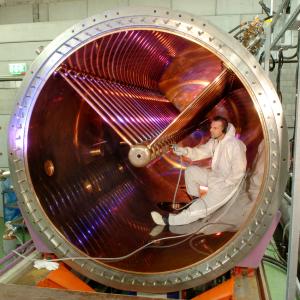Its abbreviated code is "Cn". The official name was confirmed and announced publicly by IUPAC (the International Union of Pure and Applied Chemistry) and it honors the scientific achievements of the Polish researcher and astronomer Nicolaus Copernicus

The heaviest known chemical element with atomic number 112 was first discovered at the German Research Institute GSI and since 19/02/2010 its official name is Copernicium and its abbreviated symbol is "Cn". The official name was confirmed and announced publicly by IUPAC (the International Union of Pure and Applied Chemistry) and it honors the scientific achievements of the Polish researcher and astronomer Nicolaus Copernicus (1543-1473).
The international union received the name proposed by the international research team that discovered the element (The entry in Wikipedia) led by the German scientist Sigurd Hofmann at the German Research Institute GSI.
The research team proposed the chemical symbol "Cp" for the new element. However, since this chemical symbol may be confusing since these initials have a different scientific meaning (heat capacity at constant pressure), the researchers and the association agreed to change it to the symbol "Cn". The new element is 277 times heavier than hydrogen and is therefore the heaviest known chemical element.
The proposal of the name Copernicium in honor of Nicolaus Copernicus is another link in the long tradition of determining the names of chemical elements after great scientists. The union officially announced the name of the new element on the nineteenth of February, the birthday of Copernicus. The scientist was born on 19/02/1473 in the city of Toruń, which is in Poland. His studies in the field of astronomy form the basis of today's modern theory that sees the sun as the celestial body located at the center of the solar system (the heliocentric theory - refers to the sun as the center of the universe) around which the earth and the other planets revolve.
An international team of scientists, led by scientist Sigurd Hoffmann, was able to create the element for the first time on the ninth of February in 1996. Using the existing particle accelerator at GSI, which is one hundred meters long, they accelerated zinc ions towards a lead foil. The fusion of the two atomic nuclei of these elements produced one atom of the new element 112. Similar to most elements after the element uranium (atomic number 92), Copernicium is a synthetic element created in a laboratory and its life span is very short - only fractions of a second. The scientists were able to detect the receipt of the new element by measuring the alpha particles emitted from it during its radioactive decay with the help of particularly sensitive analytical measurement methods. Additional independent experiments verified the discovery of the element. Last year the International Union recognized the existence of the 112th element, confirmed the discovery of the Institute's scientists and invited them to propose a name for it.
Copernicium is the sixth chemical element that the GSI Research Institute has proposed names for. The names of the other elements are: Bohrium (107, Bohrium, named after the physicist Niels Bohr), Hassium (108, Hassium, derived from the word Hassia, the Latin name of the state of Hesse in Germany, where the element was discovered), Meitnerium (109, Meitnerium, named after the physicist Lisa Meitner), Darmstadtium (110, Darmstadtium, named after the city of Darmstadt, where the element was discovered) and Roentgenium (111, Roentgenium, named after the German physicist Wilhelm Roentgen). Other elements named after scientists are: Einsteinium (99) named after Albert Einstein and Permium (100) named after the physicist Enrico Fermi.
Twenty-one scientists from Germany, Finland, Russia and Slovakia collaborated in the experiments that led to the discovery of this element.

7 תגובות
What is the number of protons, electrons and neutrons of this element? It's sooooooooooooooooooooooooooooooooooooooooooooooooooooooooooooooooooooooooooooooooooooooooooooooooooooooooood
To all those who try to take away their title from this institution-
An element is an element no matter what its half-life. What about a foundation with a half-life of a few days? Doesn't it evaporate?
And what about a free neutron, which has a lifetime of fifteen minutes - maybe it is not a particle according to this "logic"??
This element has a half life of 34 seconds in its most stable isotope and not just a fraction of a second, not that it matters because even if it only exists for a fraction of a second it still exists.
Even under conditions of extreme pressure and gravity, the element does not survive a fraction of a second longer, but it is still an element
I maintain that under conditions of high pressure and gravity this element can exist naturally. Such conditions exist in the universe around us
I kind of agree with a point.
Why is this a foundation? Is there any use for this element?
Wherever it is, it is already absurd to call something that evaporates immediately and is not a foundation for anything.